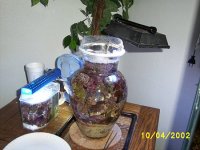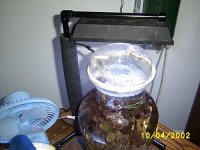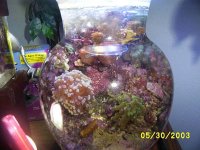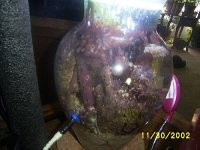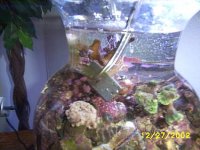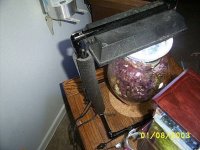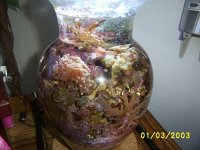You are using an out of date browser. It may not display this or other websites correctly.
You should upgrade or use an alternative browser.
You should upgrade or use an alternative browser.
To Brandon429
- Thread starter Ducman996
- Start date
Sure will, gracias
I should say this before posting these ideas>
I do not advocate buying SPS and LPS corals and keeping them in stressful containers. I advocate starting with nothing but water, rock and sand and a few test kits. Spend the first few days testing the salinity. Get a feel for calcium binding (depletion) unstocked and on a reliable calcium test kit. Same for carbonate alkalinity.
After its up and running, there is no harm in placing a few zoanthids, a leather clipping and a mushroom rock. These are all aquacultured corals, and if one wanted to travel the full spectrum of this notion one could use cultured earth rock for our LR> with age it all becomes 'live' relative to its surface area and suspended biodiversity.
At that point, there is no possible ethical argument against a reefbowl. At that point.

I should say this before posting these ideas>
I do not advocate buying SPS and LPS corals and keeping them in stressful containers. I advocate starting with nothing but water, rock and sand and a few test kits. Spend the first few days testing the salinity. Get a feel for calcium binding (depletion) unstocked and on a reliable calcium test kit. Same for carbonate alkalinity.
After its up and running, there is no harm in placing a few zoanthids, a leather clipping and a mushroom rock. These are all aquacultured corals, and if one wanted to travel the full spectrum of this notion one could use cultured earth rock for our LR> with age it all becomes 'live' relative to its surface area and suspended biodiversity.
At that point, there is no possible ethical argument against a reefbowl. At that point.
sounds good to me. :idea: Here's some pics of the vital components:
1. Plastic lid found in floral section of a store; used for potting lilies in betta bowls. When inverted, this is a perfect lid to restrict airflow and evaporation. One can line it in weatherstripping around the edges, and the cuts made to run the heater wire (6"tronic digital) and airline cable will vent the air pressure just right. Try to seal them good though.
1. Plastic lid found in floral section of a store; used for potting lilies in betta bowls. When inverted, this is a perfect lid to restrict airflow and evaporation. One can line it in weatherstripping around the edges, and the cuts made to run the heater wire (6"tronic digital) and airline cable will vent the air pressure just right. Try to seal them good though.
Attachments
The bracket for the main driver light is made from $2 painted PVC, few 'straights and ells glued into place. The lighting rotates off to the side with a twist to let one get in for maintenance, remove the lid and insert forceps. I would highly recommend getting some surgical supplies if attempting a reefbowl, they are without equal in miniature aquascaping. Wear simple sterile gloves or use tools, one gallon contaminates rather easily.
so far the best is coralife Minimight 9wx2 pc because of the square placement of the bulb. It is a very even coverage area for an 8-inch wide glass decorative vase from Wal Mart. It never overheats the system. Also, buy an azoo palm light from a place such as www.aquaticeco.com and fashion it on one of the front legs of the light stand. This light shining in will easily grow a montipora stuck in front of it, I have grown digitata straights into mini forked horns with Azoo palm lights, the bulb is a great spectrum. Don't skimp on the supplemental lighting. if you really want it to grow well, buy two palm lights and aim them both at the front glass. The one 7w actinic above is plenty. Replacement bulbs from www.hellolights.com
so far the best is coralife Minimight 9wx2 pc because of the square placement of the bulb. It is a very even coverage area for an 8-inch wide glass decorative vase from Wal Mart. It never overheats the system. Also, buy an azoo palm light from a place such as www.aquaticeco.com and fashion it on one of the front legs of the light stand. This light shining in will easily grow a montipora stuck in front of it, I have grown digitata straights into mini forked horns with Azoo palm lights, the bulb is a great spectrum. Don't skimp on the supplemental lighting. if you really want it to grow well, buy two palm lights and aim them both at the front glass. The one 7w actinic above is plenty. Replacement bulbs from www.hellolights.com
Attachments
This is what a well-aged reefbowl looks like each week. Part of the weekly maintenance is scraping it clean with a razor to keep the corals bright in the neck of the vase.
We are adding enough protein in the form of soft food morsels to support nice pod loads, and the compounds left in the water find their way into coral tissue reducing the need for direct feeding of the corals. I believe this is one of the influencing factors on the rate at which LPS and SPS frags grow in the vase. The splatter of the airstone (blocked by the lid) carries suspended particles out onto the upper rim of the vase. This is wiped with a paper towel once a week and performs substantial bowl export.
Direct feeding is done for the pods, and their leftovers are used to balance the required intake for the corals. Three inches above them is 18 watts of PC, what is lacking in watts is made up in distance.
The size of this bowl will still carry a full two weeks fed 3x a week in this manner, but its unnecessary at one gallon total capacity to go longer than a week. If one will simply change most of the water weekly, the bowl will stay very clean.
We are adding enough protein in the form of soft food morsels to support nice pod loads, and the compounds left in the water find their way into coral tissue reducing the need for direct feeding of the corals. I believe this is one of the influencing factors on the rate at which LPS and SPS frags grow in the vase. The splatter of the airstone (blocked by the lid) carries suspended particles out onto the upper rim of the vase. This is wiped with a paper towel once a week and performs substantial bowl export.
Direct feeding is done for the pods, and their leftovers are used to balance the required intake for the corals. Three inches above them is 18 watts of PC, what is lacking in watts is made up in distance.
The size of this bowl will still carry a full two weeks fed 3x a week in this manner, but its unnecessary at one gallon total capacity to go longer than a week. If one will simply change most of the water weekly, the bowl will stay very clean.
Attachments
The airline is ran down to the top of the 5 inch sandbed, and LR is placed on it to hold it down. Buy a very HQ ceramic air diffuser; if you're lucky you'll never have to replace or hassle with it. I have not had one single problem with my Tetra airstone in two years continual usage.
heater is installed along the back of the vase, slightly tilted. Rock stacked in front of it and used to hold the coral frags, blocking it from the front. The effect of 2mls/day C-Balance parts A and B cannot be understated.
Here is what I use besides coral:
1. Marquesan boxer crab (juvenile), one of the hardiest specimens in my reefs. Adds some movement to the bowl and is amazingly smart. My crab has been coming out nitely to attack my cleaning magnet for over a year now. He picks on the minute amounts of soft frog pellets fed to the system, molts regularly (each time I think he died) and grows relatively slowly. An ideal pico reef specimen.
2. 3-4 bumblebee snail, hardy workers and seemingly harmless. They have not attacked my corals as far as I can tell, I like them.
Every other day I dose a little of the C-Balance, a little Dt's and thats it. I change my reefbowl at two week intervals because the algae film is not a big deal to remove, and I enjoy performing almost no maintenance on the system.
heater is installed along the back of the vase, slightly tilted. Rock stacked in front of it and used to hold the coral frags, blocking it from the front. The effect of 2mls/day C-Balance parts A and B cannot be understated.
Here is what I use besides coral:
1. Marquesan boxer crab (juvenile), one of the hardiest specimens in my reefs. Adds some movement to the bowl and is amazingly smart. My crab has been coming out nitely to attack my cleaning magnet for over a year now. He picks on the minute amounts of soft frog pellets fed to the system, molts regularly (each time I think he died) and grows relatively slowly. An ideal pico reef specimen.
2. 3-4 bumblebee snail, hardy workers and seemingly harmless. They have not attacked my corals as far as I can tell, I like them.
Every other day I dose a little of the C-Balance, a little Dt's and thats it. I change my reefbowl at two week intervals because the algae film is not a big deal to remove, and I enjoy performing almost no maintenance on the system.
Attachments
This is how I scrape the coralline and light green film from the neck and sides of the bowl, so the viewing will stay clean and crisp. A razor blade is slightly bent to conform to the inner curve of the bowl and held with hemostats, press lightly!
Attachments
A rear shot of the spray-painted lighting stand. Insulation foam for plumbing pipes holds the wires running up the side of the 1/2 pvc tubing. In hindsight, I should have ran the wire for the heater and the air tubing up through the pipe and out a hole level with the lid, this would have concealed it much better.
Attachments
And finally, here'w what will happen with the physics of the bowl after its up and running.
1. In the early stages, before its caked with coralline and corals, the bowl will have less of a need for supplementation. Use one mL of each C-balance every other day to get a reading on your test kits, then keep them at the normal levels which is about 3mLs-3x per week of each additive (when fully aged and stocked).
The dosing amount starts small then increases relative to stocking and feeding requirements. other dosers (Turbo calcium, reef builder, liquid carbonate etc) can be used, but the dosings will vary from make to make.
2. If you use water set at .024 salinity at water change, in three days of running it will rise to .026-.027 This is something the corals will adapt to in time, and on the third day I top off with distilled water only. I suppose one could dissolve a little pickling lime in this water and circumvent the entire dosing process. Once again, test for pH, alk and ca+ when using something this strong. The whole key to accurate salinity in the reefbowl is to use a sharpie to mark your water line at water change, and don't let the evap drop the line more than a 1/4 inch if you can help it. Keep adding distilled water to keep the water line up to the original mark and salinity will hardly ever flux.
3. When setting up the bowl, don't skimp on the heater type. Buy an expensive, reliable micro heater so once it's set you won't have to mess with it again. The reefbowl needs no fanning as long as its kept in a room with good AC access, right around 72-74 degrees will translate into a reefbowl temp of 80---spot-on mark for good stony coral growth.
1. In the early stages, before its caked with coralline and corals, the bowl will have less of a need for supplementation. Use one mL of each C-balance every other day to get a reading on your test kits, then keep them at the normal levels which is about 3mLs-3x per week of each additive (when fully aged and stocked).
The dosing amount starts small then increases relative to stocking and feeding requirements. other dosers (Turbo calcium, reef builder, liquid carbonate etc) can be used, but the dosings will vary from make to make.
2. If you use water set at .024 salinity at water change, in three days of running it will rise to .026-.027 This is something the corals will adapt to in time, and on the third day I top off with distilled water only. I suppose one could dissolve a little pickling lime in this water and circumvent the entire dosing process. Once again, test for pH, alk and ca+ when using something this strong. The whole key to accurate salinity in the reefbowl is to use a sharpie to mark your water line at water change, and don't let the evap drop the line more than a 1/4 inch if you can help it. Keep adding distilled water to keep the water line up to the original mark and salinity will hardly ever flux.
3. When setting up the bowl, don't skimp on the heater type. Buy an expensive, reliable micro heater so once it's set you won't have to mess with it again. The reefbowl needs no fanning as long as its kept in a room with good AC access, right around 72-74 degrees will translate into a reefbowl temp of 80---spot-on mark for good stony coral growth.




